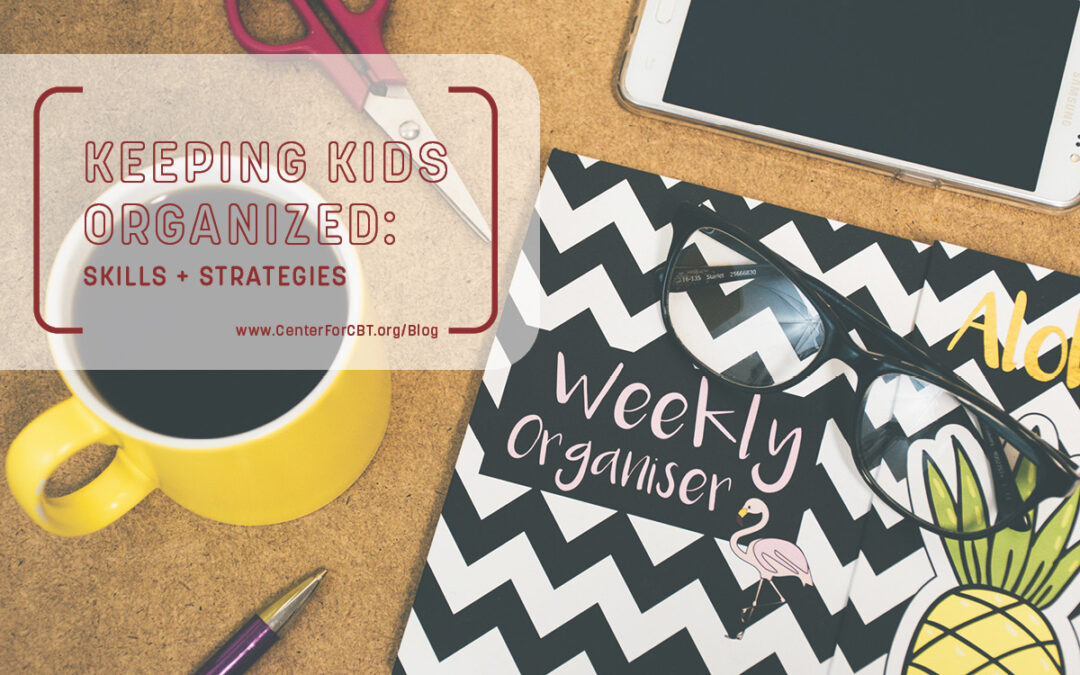Many children struggle with organization, and those difficulties may be exacerbated given the current circumstances of the pandemic and remote learning. Although strategies to stay organized may seem intuitive to parents, these skills need to be explicitly taught to many students. The best way to help your child adjust to the new challenges presented by this school year is to work with them to create a routine that will encourage them to stay organized. Developing these skills now will help your child better manage their schedule in school, making it easier for them to tackle bigger responsibilities later in life.
Organizing the Day
It is helpful for children to have a regular daily schedule; this is especially true for students who are engaged in remote learning. Establishing a daily routine helps start the school day on the right track by preparing students to complete all expected tasks, and also set them up for what’s next. For example, it is ideal to have the same morning routine daily. After a child wakes up, they may be expected to make their bed, get dressed, eat breakfast, and brush their teeth. If a child is used to completing these tasks in the same order every morning, it is more likely they will be completed regularly and in a timely fashion. In addition, completion of one task will likely be linked to starting the next task, or in other words, remind the child of the next task in the sequence.
If a child has difficulty remembering the sequence of a routine or regularly forgets a step, a visual schedule may be helpful. Younger children may benefit from seeing a schedule with pictures representing the task, or even actual photographs of the child completing the task.For older children, a simple color-coded schedule will do the trick. In any case, your child’s schedule should be posted in a highly visible area so that they can refer to it often, such as by their desk or in the kitchen, or wherever they tend to do their work. This helps remind your child to use the schedule, especially when they are unsure of what comes next. In some cases families will make a visual schedule, only to find their child does not use it. If this is the case in your household, try to use a checkmark or some other indication that the task is complete.
Important Skills to Target
Given the fundamental differences in virtual learning versus in person classes, you may notice your child becoming more disorganized and frazzled without their previous routine and classroom structure. In their book The Organized Child: An Effective Program to Maximize Your Kid’s Potential–in School and in Life, Richard Gallagher, Ph.D., and his colleagues identified the following four areas to target when teaching organizational skills:
1. Tracking Assignments
2. Managing Materials
3. Time Management
4. Task Planning
Even if your child does not have a formal diagnosis of attention-deficit/hyperactivity disorder (ADHD), these skills can be helpful in keeping students organized. Let’s take a closer look at each of these areas to guide you through how to help your child implement these skills.
Tracking Assignments
Many teachers regularly check students’ planners or homework logs to ensure they have all of their assignments written down. Since so many children are now learning remotely, parents may have more of that responsibility given the nature of virtual learning. In order to help your child manage assignments with a checklist or homework log, here are three important steps:
1. Record assignments. Students should have a notebook or planner with enough room to write down the details of each assignment, including due dates
2. Prioritize. Generally, it is best to start with difficult assignments. Subjects that require more effort or thinking might regularly appear at the top of the checklist
3. Double-check. Parents should double-check that assignments are recorded correctly and are completed by the due date
Depending on a child’s age and baseline organizational skills, different components of this process should be rewarded with labeled praise such as “Great job focusing to complete your work!” or “I’m really proud that you came up with a solution to solve that problem.” Even tangible positive reinforcement can be helpful, like putting a sticker,stamp, or a star on a progress chart. For some children it might be helpful to create a reward system where a certain number of stars allows them to earn a bigger reward, such as a small toy or being allowed to choose what’s for dinner. For older adolescents, rewards might include similar opportunities or privileges related to their interests. The goal is to motivate students to utilize the checklist or homework log, which will help them manage their assignments consistently.
Managing Materials
Is your child’s backpack or room typically a mess? Does your child frequently leave their book at school or forget their homework? Whether your child is learning remotely, attending school in-person, or a hybrid of both, keeping materials organized is challenging for many students. Here are some tips to help your child manage their academic materials:
1. Create a system. Whether your child uses a binder or folder to manage school papers, it is important to have a system that is easy to utilize. Papers can be organized by subject and/or categories such as homework, notes, assignment instructions, etc. The goal is to implement an easy-to-use system that your child understands
2. Have a “catch-all” folder. For students who are used to shoving everything in the bottom of their backpack, having a “catch-all” folder may also be helpful. This allows them to put all of their papers in one place throughout the day, alleviating the stress that some students experience when transitioning between subjects. The key is to ensure reorganization of these papers into their appropriate sections later that day, which will be an important part of their regular routine
3. Keep other materials in one place. Miscellaneous items, such as pencils, erasers, ruler, etc. are best kept in a pencil box or case that is at hand during remote learning, or remains in a child’s classroom desk or locker at school
For children who are attending school in-person, it is important to always check for materials before heading to school, as well as before returning home. For example, part of your child’s routine may be to check with them for homework, books, and their lunchbox the night prior or morning of school. For children who are participating in remote learning, it is likely easiest to keep all of a child’s materials wherever they have virtual classes and complete their assignments.
Time Management
Many students tend to underestimate how long it takes to complete daily activities and tasks. In addition to procrastinating, it is not uncommon for students to put off homework until later because they believe they will have enough time to finish before bedtime. As the day comes to an end, students may start to scramble and become flustered as they realize they did not allot nearly enough time for their academic work. This can lead to loss of sleep to complete the work or not finishing their work on time.
One way to help students understand how long it actually takes them to complete a task is to gather data. Have your child time themselves completing a variety of tasks. You may try daily activities such as getting dressed or making their bed. You might then try more academically-related tasks such as reading 20 pages or creating an outline for a paper. It is likely your child may be surprised by how long it takes to complete these activities. This information can then inform how to help your child plan their time so they are able to complete all expected assignments and tasks.
Task Planning
Is your child the type of student that begins projects the night before they’re due? This is not uncommon for children with planning weaknesses. Here are a few steps to help students with long-term projects:
1. Break it down – Divide the assignment or task into smaller, more manageable steps
2. Materials – You and your child should determine how much time and what materials may be needed for each step. It is always advised to allot extra time for each step in case something takes longer than expected
3. Interim due dates – For many students, it is helpful to have due dates for each of the steps, rather than focusing solely on the final due date for the whole project
Maintaining Skills Over Time
Many students are not inherently organized, so practicing these skills over time is crucial. Providing positive reinforcement is also key in shaping these behaviors. When children do well, be specific with your praise. For rewards that may be offered for good work, parents might find these become less motivating over time. Rewards will likely need to be changed and varied to keep students interested in continuing to exhibit these skills.
A collaborative support system is also important. Working with teachers, school staff, tutors, and other adults in your child’s life will ensure everyone is aware of the target skills and praising specific behaviors. Building these skills throughout your child’s schooling will help prepare them for future success and give them the tools to achieve whatever goals they may set for themselves.


